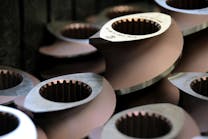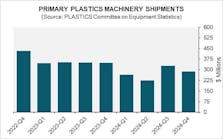By Karen Hanna
As oil prices hit 14-year highs and gas prices jump to $4 a gallon or more, manufacturers should gird themselves for the possibility that resin prices, too, will continue to climb, as Russia’s intensifying war with Ukraine creates volatility across the industry.
“It is a very fluid situation,” said Esteban Sagel, CEO and principal at Chemical & Polymer Market Consultants (ChemPMC), a Houston agency that provides research to the chemicals industry. “It’s not clear to me where the situation in Ukraine is going, what kind of escalation can happen and how bad it can get beyond what it is already, which is terrible.”
Increases in energy costs had Sagel concerned even before Russia escalated its hostilities against Ukraine. With sanctions on Russia — a major producer of oil — costs for goods for both resin manufacturers and buyers are tied to events overseas.
“If we continue our sanctions against Russia and you see that oil exports from Russia get also targeted, then that is going to have a massive impact on the global energy industry, with oil prices and almost all energy products’ prices moving higher, so a massive increase in costs,” Sagel said.
The true effects might not be discernible for months, as many purchase contracts are finalized at the end of the year, said Sagel, who studies the PE and PP markets.
“If I’m a buyer, I have a lot of concerns right now. I have concerns about the cost of the polymers. I don’t know where they’re going to be going. I still need to be worried about weather because that’s still something that can impact our industry, if we have a very active hurricane season. So, there is a lot more volatility and things that are concerning for a buyer going forward. I cannot give you advice in what to do; I would just say that they have to be extremely careful in their purchasing decisions,” Sagel said.
Some buyers, worried that prices could go higher, might make spot purchases of resin, while other buyers might hold off, banking on logistics issues to constrain domestic resin producers from selling excess supply abroad.
Sagel said U.S. producers can manufacture more PE than domestic processors need, but domestic PP capacity is a lot tighter.
Because Asian producers use naphtha, an oil derivative, to make PE resins, they’ve been particularly hard-hit by increases in the prices of oil and its byproducts. On the other hand, North American producers use other feedstocks, such as natural gas, and, while prices for those commodities are climbing, they’re not going up as fast.
That could make U.S.-produced PE more attractive abroad — if domestic producers can continue to absorb problems and costs associated with shipping. If not, overcapacity of PE domestically could push prices down.
“We have companies left and right leaving Russia, and how does the overall logistical system respond to higher energy prices, which probably will result in higher costs to transport, and how does that impact our ability to export?” Sagel said. “This is one thing that I don’t really know yet.”
He acknowledged it’s all too soon to tell, with each day’s events holding sway over the markets.
“We could see a cease-fire, we can stop the cancellation of the Russian economy, and then things move faster in the opposite direction. Or we can see an escalation, with a wider world war taking place, which would have a massive impact on energy costs and prices. And, so, it’s hard to predict because it is not a rational thing we’re confronting right now. It’s very irrational.”
Contact:
Chemical & Polymer Market Consultants, Houston, www.chempmc.com, contact@chempmc.com
More on the war in Ukraine
Check out our additional coverage on the war in Ukraine and how it's affecting the plastics industry:
3D printing companies suspend business in Russia.
FlexBlow shifts its strategy in light of the invasion.
Endeavor Business Media examines the effects on business from multiple angles.
Karen Hanna | Senior Staff Reporter
Senior Staff Reporter Karen Hanna covers injection molding, molds and tooling, processors, workforce and other topics, and writes features including In Other Words and Problem Solved for Plastics Machinery & Manufacturing, Plastics Recycling and The Journal of Blow Molding. She has more than 15 years of experience in daily and magazine journalism.






